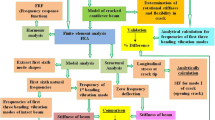Abstract
In this paper, we present a simple predictive model to estimate the natural frequencies of steel cantilever beams with branched cracks. The model considers the cracked beam as a beam with constant cross-section, on which acts an equivalent bending moment. This bending moment takes into account the modification of the rigidity on the beam segment on which the crack extends in the longitudinal direction and the additional rotation that occurs in the slices located at the ends of the damaged segment. Along with the theoretical background and the deduced mathematical model, we present several cases of deterioration defined by the depth of the transverse crack branch respectively the position and the extension of the longitudinal branch. These examples prove the accuracy of the predictions regarding the change of the natural frequencies due to the damage obtained with the proposed model.
Access this chapter
Tax calculation will be finalised at checkout
Purchases are for personal use only
Similar content being viewed by others
References
Khatir, S., Dekemele, K., Loccufier, M., Khatir, T., Wahab, M.A.: Crack identification method in beam-like structures using changes in experimentally measured frequencies and particle swarm optimization. Comptes Rendus Mécanique 346(2), 110–120 (2018)
Naniwadekar, M.R., Naik, S.S., Maiti, S.K.: On prediction of crack in different orientations in pipe using frequency based approach. Mech. Syst. Signal Process. 22(3), 693–708 (2008)
Gillich, G.R., Minda, P.F., Praisach, Z.I., Minda, A.: Natural frequencies of damaged beams - a new approach. Rom. J. Acoust. Vib. 9(2), 101–108 (2012)
Vlase, S., Marin, M., Öchsner, A.: Considerations of the transverse vibration of a mechanical system with two identical bars. Proc. Inst. Mech. Eng. Part L: J. Mater.: Des. Appl. 233(7), 1318–1323 (2019)
Gillich, G.R., Wahab, M.A., Praisach, Z.I., Ntakpe, J.L.: The influence of transversal crack geometry on the frequency changes of beams. In: Proceedings of International Conference on Noise and Vibration Engineering (ISMA2014) and International Conference on Uncertainty in Structural Dynamics (USD2014), pp. 485–498, Leoben (2014)
Onchis, D.M., Gillich, G.R., Frunza, R.: Gradually improving the readability of the time-frequency spectra for natural frequency identification in cantilever beams. In: 2012 Proceedings of the 20th European Signal Processing Conference (EUSIPCO), pp. 809–813. IEEE, Bucharest (2012)
Gillich, G.R., Mituletu, I.C., Negru, I., Tufoi, M., Iancu, V., Muntean, F.: A method to enhance frequency readability for early damage detection. J. Vib. Eng. Technol. 3(5), 637–652 (2015)
Gillich, G.R., Mituletu, I.C., Praisach, Z.I., Negru, I., Tufoi, M.: Method to enhance the frequency readability for detecting incipient structural damage. Iran. J. Sci. Technol. Trans. Mech. Eng. 41, 233–242 (2017)
Khatir, S., Wahab, M.A., Boutchicha, D., Khatir, T.: Structural health monitoring using modal strain energy damage indicator coupled with teaching-learning-based optimization algorithm and isogeometric analysis. J. Sound Vib. 448, 230–246 (2019)
Gillich, G.R., Praisach, Z.I., Onchis, D.M., Gillich, N.: How to correlate vibration measurements with FEM results to locate damages in beams. In: Proceedings of the 4th WSEAS International Conference on Finite Differences - Finite Elements - Finite Volumes - Boundary Elements, pp. 76–81. WESEAS Press, Paris (2011)
Dimarogonas, A.D.: Vibration of cracked structures: a state of the art review. Eng. Fract. Mech. 55, 831–857 (1996)
Ravi, J.T., Nidhan, S., Muthu, N., Maiti, S.K.: Analytical and experimental studies on detection of longitudinal, L and inverted T cracks in isotropic and bi-material beams based on changes in natural frequencies. Mech. Syst. Signal Process. 101(15), 67–96 (2018)
Cheng, H., Zhou, X.: An energy-based criterion of crack branching and its application on the multidimensional space method. Int. J. Solids Struct. 182–183, 179–192 (2020)
Shen, Y., Wu, C., Wan, Y.: Universal meshes for a branched crack. Finite Elem. Anal. Des. 129, 53–62 (2017)
Lee, J., Hong, J.W.: Dynamic crack branching and curving in brittle polymers. Int. J. Solids Struct. 100–101, 332–340 (2016)
Tufisi, C., Gillich, G.R., Hamat, C.O., Manescu, T.J.: Study regarding the effect of crack branching on the eigenfrequencies of beams. In: Proceedings of the 13th International Conference on Damage Assessment of Structures, pp. 79–91. Springer, Porto (2020)
Tufisi, C., Gillich, G.R., Hamat, C.O., Gillich, N., Praisach, Z.I.: Numerical study of the stiffness degradation caused by branched cracks and its influence on the natural frequency drop. Rom. J. Acoust. Vib. 15(1), 53–57 (2018)
Christides, S., Barr, A.D.S.: One-dimensional theory of cracked Bernoulli-Euler beams. Int. J. Mech. Sci. 26(11/12), 639–648 (1984)
Author information
Authors and Affiliations
Corresponding author
Editor information
Editors and Affiliations
Rights and permissions
Copyright information
© 2021 The Author(s), under exclusive license to Springer Nature Switzerland AG
About this paper
Cite this paper
Gillich, GR., Tufisi, C., Nedelcu, D., Praisach, ZI., Hamat, C.O. (2021). A New Concept Regarding the Modeling of Steel Cantilever Beams with Branched Cracks: A Case Study. In: Rizzo, P., Milazzo, A. (eds) European Workshop on Structural Health Monitoring. EWSHM 2020. Lecture Notes in Civil Engineering, vol 128. Springer, Cham. https://doi.org/10.1007/978-3-030-64908-1_19
Download citation
DOI: https://doi.org/10.1007/978-3-030-64908-1_19
Published:
Publisher Name: Springer, Cham
Print ISBN: 978-3-030-64907-4
Online ISBN: 978-3-030-64908-1
eBook Packages: EngineeringEngineering (R0)




